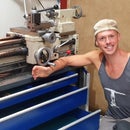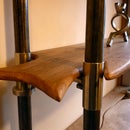Introduction: Disco Coffee Table
This table evolved itself as I worked on it and materials were collected. It started with a big old ash log that forms the top. That slab was awesome and had a good quantity of swirly mad n deep 'naturalness' that I didn't want to loose.
To make it flat I tweaked one of the corners with some blue resin, and then I was on the jazzy disco road and couldn't escape. The 'sound reactive live edges' were the result.
The legs were a consequence of the usual "what other cool up-cycled materials can I combine with this?" question.
Step 1: Chainsaw Milling
So here is the very log being milled with my home made chainsaw mill (see my 'able on the CS Mill build and use tips here). Unlike most of the stuff I mill, this big ash log had been lying in the field for a couple of years so was quite weathered. After stripping the bark, I noticed some interesting insect tracks, and was worried that it would be all hole ridden. Not so :)
I cut it up into 2" thick slabs, and the inside faces were gorgeous, so I carefully stacked and set it to dry.
Step 2: Flatten the Slab
Two years later...
I bring it into the warm workshop, to dry for a further couple of months.
Inevitably it did some twisting and warping as it dried. And one end, despite being left-over-paint sealed, has a fairly big crack, that will need addressing.
First things first though lets get it somewhat flat. This slab is quite a bit too wide to fit through the thicknesser, so I made the rudimentary router sled you can see in the pics. I was skeptical, but apart from being horrendously messy (think wood shavings down your pants and in your computer's dvd drive) and a bit time consuming, it actually worked quite nicely.
Step 3: Fixing Up the Low Corner
I didn't want to shave another couple of centimeters off the whole slab just to get it flat with this very corner bit - that seemed super wasteful, not to mention I had had quite enough of router shavings in my teeth by then thank you.
Instead I thought I would build up the corner using some aluminium scraps embedded in the wood, to stabilize a fill of epoxy resin and aluminium swarf. The semi-translucent blue is made from mixing in some blue laser printer toner I salvaged for just such an experiment.
I started by sorting through my alu scrap and penciling in a design that seemed to fit. Then I cut 3mm wide channels in the slab's offending corner, using the router and a 2x4 clamped on as a guide edge. As you can probably see I cut a little bow-tie to sort out the little crack there, that gets incorporated into the grid-like design.
It is at this stage that I thought it would be cool to embed some LEDs in the epoxy, and make them sound reactive. Thus before filling, I drilled and placed some in, using hot melt glue to seal round the wires, so resin wouldn't leak through to the other side.
Step 4: Flatten the Fix
After the epoxy was set I removed the clamped on 'shuttering' and used the same router sled to flatten the corner's surface. I am much more vigilant in my PPE when working with epoxy and full cyborg breathing apparatus and open door ventilation was in effect.
After the routing I gave it a little sand and I have to say, I thought it was looking pretty cool :)
Step 5: Prepping a Leg
So this scrap of old steel girder has been knocking about for a good while, quietly waiting its turn to be used in a project. I thought it would make a rather cool leg, as well as acting as a kinda bow tie insert to stop the big crack from further opening.
Anyway, my angle grinding was somewhat sloppy, when cutting to size and both ends needed squaring up. Luckily the Big Disc Sander I made was just about big enough to pull it off with style.
Step 6: Fixing the Leg in Place
I won't lie, this was tricky and time consuming! I started by placing the I beam where I wanted it to go and carefully drawing round the edge with a pencil.
Then I used the circular plunge saw, router, and chisel (oh dear god so much chiseling) to remove the material, test fit, and repeat x100.
Step 7: Metal Leg Stabilizes Crack
So once I was happy with the I beam fit, I epoxied it into place and filled the crack...
Step 8: Soldering Up the LED's
You might think it would be sensible to do the other two lags at this point, but that's not what I did, because I wasn't yet sure what to make them from.
Instead I was getting excited by the LED discoifying.
I used neopixels. Each one is a "full-color LED. Red, green and blue LEDs are integrated alongside a driver chip into a tiny surface-mount package controlled through a single wire." You can learn all about them here - https://learn.adafruit.com/adafruit-neopixel-uberguide/overview
I used some singles, and some lengths of strip for along the edges. See the in-pic notes for details.
Step 9: LED's Embedded in Voids
So this is the void that gets filled and LEDifyed. I basically used the same technique as with the corner, excepting this gets filled from underneath, and some polycarbonate repair tape is used to retain the resin.
Step 10: Side LED Prep
The side LED emplacement was somewhat trickier... Here's what I did.
First I used tracing paper a drew where I thought the groove that would house the LED strip should go.
Then I stuck that to some thin scrap ply I fished from a skip some time ago.
The shape was cut out on the bandsaw, and the ply was then clamped to the slab (pic 4), where it was used as a template for a guided router bit.
Step 11: LED Windows
So now we have a groove for the LED strip and wiring to go, we need a way to see the LED lights.
I made a rough jig (a wooden block) to ensure I drilled in the right place and square. Then the holes were blown clear with compressed air and the strip was installed... How exciting.
Step 12: Testing LEDs
Ahh HA. The moment when things light up!
Step 13: Securing
Before securing in position, I double checked everything was working. Then I cut a load of scraps of wood to the right thickness and glued them in place.
Step 14: Legs - the Other Ones
So at the moment we have one leg, and this table wants three.
Three, you say, Why three? Well the minimalist aesthetic is cool, besides two of the I beams each end would be ridiculous. Plus, with three legs you eliminate the chances of annoying rocky-abouty-ness on slightly uneven floors, which you often get with four legs.
OK anyway, I decided to use an old driveshaft my friend gave me after it broke and I helped him replace it...
I started by planning it all out, holding things at various angles and seeing how they looked. When happy I drilled an angled hole in an oak block, with a holesaw. This acted both as a leg brace and drill guide for the holes I needed to make in the slab's under side ... See photo notes for details,
Step 15: Drive Shaft Prep
After cutting the drive shaft in half to make two legs I was into the making things look nice phase. There was plenty of grease and grime in these babies that needed cleaning off.
They also needed a little extension to be long enough. I used some scrap gas pipe to lengthen...
Step 16: Locking Angles and Fiddly Bits
To make the ends of the legs match up a bit, I made a little extension for one, using some steel rod.
There was a good amount of fussing and fiddling to try and get the angle of the drive shaft's joint just right before the big weld and they were locked there forever. Lets just say there was some tack welding and grinding away of same tack welding, and re-tack welding before things found their rightful place.
Step 17: Legs Check!
So I just need to put some felt pads on the base of the feet and we are good to go.
Step 18: Final Sanding
Yep its that time. I must admit I really don't like sanding very much.
I work up through the grits from 80 to 240. It will be finished with a wax oil so higher than 340 is just a waste of time, and can actually stop the wax-oil adhering properly to the wood.
A side light helps show up the defects.
Step 19: Arduino and Electronics
The electronics are all housed in this little wooden enclosure, and two battery boxes are velcro attached to the I beam. .
I am basically using the sound reactive sketch provided by Adafruit, but have attached it here anyway.
I am using an Arduino nano with the Adafruit MAX4466 with Adjustable Gain mic amp. There is a hole in the enclosure that the mic is mounted to.
The two battery boxes take 4 batteries each (one set powers the LEDs, the other the arduino). If you go this route the AA batteries MUST be the rechargeable ones or the voltage is too high. But on the plus side you don't need to use the rather inefficient voltage regulator so battery life will be better.
If you don't have separate power supplies for the LED, the Arduino and mic suffer from all kings of noise interference, things don't run smoothly, and Adafruit will come and tell you off for putting the LED string at risk.
Attachments
Step 20: The Disco Table
So that's about it. Hope you got some ideas from this instructable. If you liked it, consider liking the Flowering Elbow facebook page where I post pics of things I am working on.

Participated in the
Trash to Treasure Challenge














